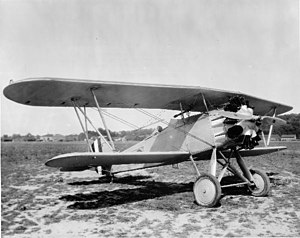
The Curtiss Falcon was a family of military biplane aircraft built by the American aircraft manufacturer Curtiss Aeroplane and Motor Company during the 1920s. Most saw service as part of the United States Army Air Corps as observation aircraft with the designations O-1 and O-11, or as the attack aircraft designated the A-3 Falcon.

The Grumman F2F was a single-engine, biplane fighter aircraft with retractable undercarriage, serving as the standard fighter for the United States Navy between 1936 and 1940. It was designed for both carrier- and land-based operations.

The Curtiss SOC Seagull was an American single-engined scout observation seaplane, designed by Alexander Solla of the Curtiss-Wright Corporation for the United States Navy. The aircraft served on battleships and cruisers in a seaplane configuration, being launched by catapult and recovered from a sea landing. The wings folded back against the fuselage for storage aboard ship. When based ashore or on carriers the single float was replaced by fixed wheeled landing gear.

The Curtiss XF14C was an American naval fighter aircraft. It was developed by Curtiss-Wright in response to a request by the United States Navy in 1941 to produce a new shipboard high-performance fighter aircraft.

The Grumman FF "Fifi" was an American biplane fighter aircraft operated by the United States Navy during the 1930s. It was the first carrier aircraft with retractable landing gear. It was produced under licence in Canada and known as the Goblin in Canadian service and Delfín in Spanish service.

The Vought XF3U was the prototype of a two-seat, all-metal biplane fighter, built by Vought Aircraft Company of Dallas, Texas for the United States Navy.

The Vought SBU-1 Corsair was a two-seat, all-metal biplane dive bomber built by Vought Aircraft Company of Dallas, Texas for the US Navy. Its design was based upon the F3U-1 two-seat fighter that was abandoned when the Navy decided not to obtain any more two-seat fighters.

The Boeing Model 15 was a United States single-seat open-cockpit biplane fighter aircraft of the 1920s, manufactured by the Boeing company. The Model 15 saw service with the United States Army Air Service and with the United States Navy as a carrier-based fighter.

The Boeing F2B was a biplane fighter aircraft of the United States Navy in the 1920s, familiar to aviation enthusiasts of the era as the craft of the Three Sea Hawks aerobatic flying team, famous for its tied-together formation flying.

The Boeing F3B was a biplane fighter and fighter bomber that served with the United States Navy from 1928 into the early 1930s.

The Curtiss F6C Hawk was a late 1920s American naval biplane fighter aircraft. It was part of the long line of Curtiss Hawk airplanes built by the Curtiss Aeroplane and Motor Company for the American military.

The Curtiss F7C Seahawk was a carrier-capable biplane fighter aircraft of the United States Navy Marine Corps in the late 1920s and early 1930s.

The Boeing P-29 and XF7B-1 were an attempt to produce a more advanced version of the highly successful P-26. Although slight gains were made in performance, the U.S. Army Air Corps and U.S. Navy did not order the aircraft.

The Martin T4M was an American torpedo bomber of the 1920s. A development by the Glenn L. Martin Company of their earlier Martin T3M, and, like it a single-engined biplane, the T4M served as the standard torpedo bomber aboard the aircraft carriers of the United States Navy through much of the 1930s.

The Curtiss XF15C-1 is a mixed-propulsion fighter prototype of the 1940s. It was among a number of similar designs ordered by the US Navy before pure-jet aircraft had demonstrated their ability to operate from carriers and the mixed-propulsion designs were abandoned. Only three prototypes were constructed, the first one having crashed in testing while the second was scrapped and the last survives to this day.

The Wright XF3W was an American racing aircraft built by Wright Aeronautical for the United States Navy.

The Northrop XFT was an American prototype fighter aircraft of the 1930s. A single engined low-winged monoplane, it was designed and built to meet a United States Navy order for an advanced carrier based fighter. It exhibited poor handling, and was rejected by the Navy, the single prototype being lost in a crash. A variant, the Northrop 3A, also was unsuccessful.

The Douglas XP3D was a prototype American patrol flying boat of the 1930s. A twin-engined high-winged monoplane, the P3D was produced by the Douglas Aircraft Company to equip the US Navy's Patrol squadrons, but despite meeting the Navy's requirements, the rival Consolidated PBY was preferred owing to a lower price.

The Vought V-141 was a prototype American single-seat fighter aircraft of the 1930s. It was a development of the unsuccessful Northrop 3-A design, but was itself a failure, being rejected by the United States Army Air Corps. The sole prototype was sold to the Japanese Army in 1937, but no production followed, with the type proving to be inferior to existing Japanese fighters.

The Berliner-Joyce XF2J was the company's second biplane fighter for the United States Navy. The XF2J was ordered on 30 June 1931 and although designated as a two-seat fighter, it was used as an observation aircraft.




















